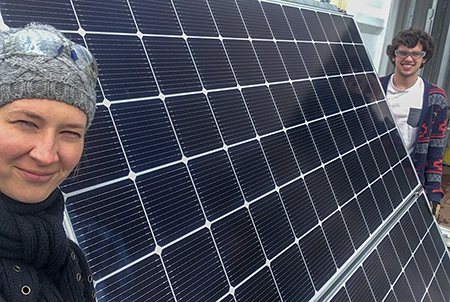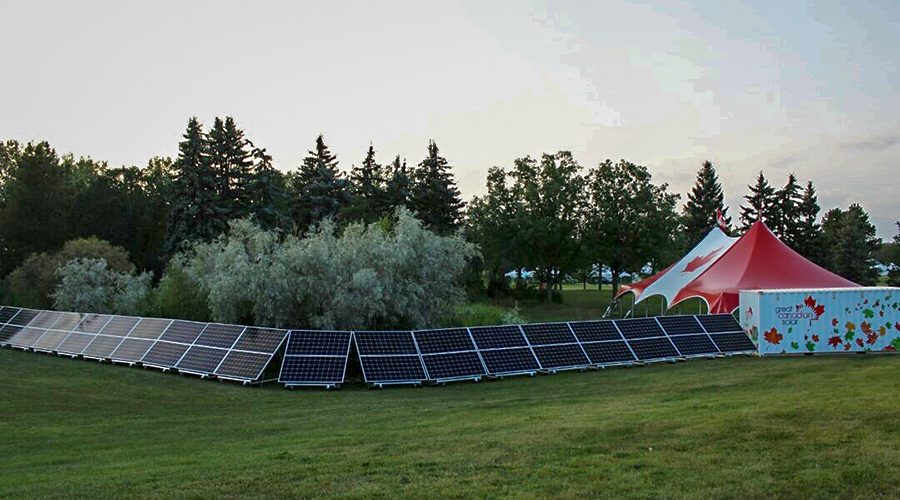Csilla Harsasi turns student project into new career in alternative energy
Driving across the abandoned pavement and morass of muck that’s been unearthed at the Blatchford redevelopment, it’s easy to forget this sprawling former airport is located in the heart of Edmonton.
Just past the fleet of earth-movers, round the pickup parking area and behind a row of mobile office trailers sits a white metal shipping container. The only thing distinctive about it is the bright, red maple leaf logo of “Great Canadian Solar.”
“This is our seacan,” renewable energy technologist Csilla Harsasi says proudly.
With that, the hardhat-clad Harsasi (Alternative Energy Technology ’18) takes several careful steps through the mud and unlocks the box to reveal what’s inside – and why she and classmate Aaron Mcgregor (Alternative Energy Technology '18) spent about a year consumed by thoughts of seacans. The recycled shipping container is much more than a storage unit; it has the power to reduce greenhouse gas emissions and bring power to construction sites almost anywhere.
Solar to go
The standard-sized container is mostly unremarkable – and empty – save for a small nook in the back where there’s some fancy-looking gear. It’s actually the heart of the seacan – a bank of batteries, inverters and charge controllers that harnesses energy from 44 lightweight portable solar modules.
The seacan also stores those modules, which are foldable and housed on racks mounted on the ceiling. When deployed in the field, the solar array and backup generator – which can run fully on biodiesel – generates enough power for one to two medium-sized homes, Harsasi explains.
At Blatchford, a massive 217-hectare mixed-use infill community, the array powers two office trailers for the site contractor, Chandos Construction. It replaced two large propane generators, cutting greenhouse gas emissions and saving about $1,200 a month in fuel, Harsasi says.
The entire setup took about two hours to install. Once in place, it needs little upkeep and can even withstand wind gusts of 60 kilometres per hour, she says. That makes it an ideal power supply for construction projects, remote oilfield sites or even the Far North, she says.
“You don’t need to know anything about solar to use one of these and you don’t need one of us [experts] to set it up. It’s pretty much an off-the-shelf product.”
Changing how companies do business
Harsasi and Mcgregor started working on the project for their final assignment, or capstone, in Alternative Energy Technology. The duo took a concept developed by Great Canadian Solar and started researching designs for a prototype array and storage unit last fall.
 With refinements, gen-2.0 is bigger and can store even more solar modules. The system is built for fast-charging, Harsasi says, which helps reduce the size of the batteries.
With refinements, gen-2.0 is bigger and can store even more solar modules. The system is built for fast-charging, Harsasi says, which helps reduce the size of the batteries.
For a former international student from Hungary with an undergrad in security and defence policy, working with solar cells at a muddy construction site in northern Alberta is quite a departure. But it’s also exactly where Harsasi wants to be; Great Canadian hired her right out of school.
“As a grad, she brings a wealth of technical experience and having her as a summer student last year really added to her hands-on knowledge,” says Clifton Lofthaug (Electrical Engineering Technology ’04), the company’s founder and president.
“It’s going to cut down emissions significantly.”
Lofthaug says the solar seacan is not only perfect for remote locations but also for companies looking to change how they do business. It took all of “five minutes” to get Chandos on board and help test the product, he says.
“To build green, this makes all the sense in the world. It’s going to cut down emissions significantly.”

The seacan array made its public debut in front of 345,000 people at Edmonton’s Heritage Festival in August. The solar modules helped the city’s biggest festival cut power costs and move closer to being net zero.
The seacan array will remain at Blatchford through the winter and spring so Harsasi and the team can continue to gather evaluate its performance. Lofthaug says he has a few more improvements in mind before taking the next generation to market.